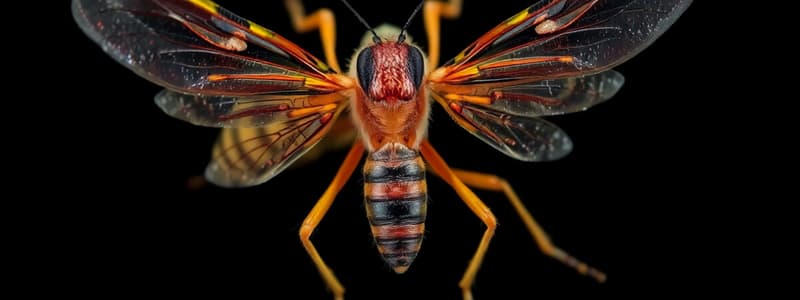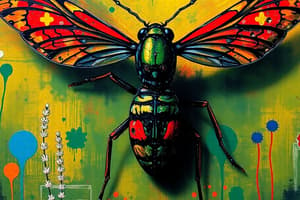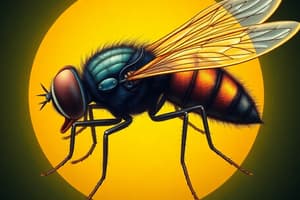Podcast
Questions and Answers
What is the primary focus of forensic entomology?
What is the primary focus of forensic entomology?
- Examining insect infestations at crime scenes (correct)
- Investigating climate effects on insect populations
- Analyzing the nutrients in decomposing cadavers
- Studying the genetic makeup of insects
Which family of insects is considered particularly useful in forensic investigations?
Which family of insects is considered particularly useful in forensic investigations?
- Formicidae
- Calliphoridae (correct)
- Aphididae
- Culicidae
What term describes insects that consume decomposing bodies?
What term describes insects that consume decomposing bodies?
- Carnivorous insects
- Decompositional insects
- Necrophagous insects (correct)
- Autophagous insects
How quickly can insects be attracted to a corpse after death?
How quickly can insects be attracted to a corpse after death?
What has forensic entomology recently evolved into?
What has forensic entomology recently evolved into?
What aspect do forensic entomologists critically evaluate at crime scenes?
What aspect do forensic entomologists critically evaluate at crime scenes?
In relation to forensic science, what was the historical perception of insect larvae during autopsies?
In relation to forensic science, what was the historical perception of insect larvae during autopsies?
Which of the following is TRUE about the diversity of insects?
Which of the following is TRUE about the diversity of insects?
What is the primary reason forensic entomologists consider the dietary habits of insects?
What is the primary reason forensic entomologists consider the dietary habits of insects?
Which insect is specifically mentioned as a delicacy in South-eastern Asia?
Which insect is specifically mentioned as a delicacy in South-eastern Asia?
What identification method has been improved to analyze immature insect stages more effectively?
What identification method has been improved to analyze immature insect stages more effectively?
Which of the following statements about insect structure is true?
Which of the following statements about insect structure is true?
In what region is mass production of crickets for food prominently noted?
In what region is mass production of crickets for food prominently noted?
Why is knowledge of insect structure essential for forensic entomologists?
Why is knowledge of insect structure essential for forensic entomologists?
What are the characteristic body segments of insects?
What are the characteristic body segments of insects?
What role do insects play in nutrition, particularly in African diets?
What role do insects play in nutrition, particularly in African diets?
What are the three main sections of an insect's body?
What are the three main sections of an insect's body?
Which part of the thorax bears a pair of wings in certain life stages?
Which part of the thorax bears a pair of wings in certain life stages?
In which order do the segments of an insect leg appear?
In which order do the segments of an insect leg appear?
What is the purpose of identifying insect features in forensic entomology?
What is the purpose of identifying insect features in forensic entomology?
Which insect family is particularly emphasized for identification in forensic research?
Which insect family is particularly emphasized for identification in forensic research?
What should researchers focus on regarding larval stages of insects?
What should researchers focus on regarding larval stages of insects?
How can forensic researchers improve the accuracy of their investigations?
How can forensic researchers improve the accuracy of their investigations?
What type of insect structure divides the insect body into three sections?
What type of insect structure divides the insect body into three sections?
Flashcards are hidden until you start studying
Study Notes
Forensic Entomology: Overview
- Forensic entomology investigates insects associated with crime scenes, particularly those found on corpses or cadavers.
- Experts use insect characteristics and habitats to determine their role in the case and estimate the time of death.
- The study of forensic entomology has transitioned into entomotoxicology, analyzing toxins found in insects that have fed on decomposing remains.
Insect Identification
- Forensic entomologists focus on identifying insect species found at crime scenes.
- Insect taxonomists have created identification keys to help entomologists identify species morphologically.
- DNA analysis is now used to identify insects, even in their immature stages, offering advantages over traditional methods.
Importance of Insects
- Insects are crucial to forensic investigations, especially the true flies (Calliphoridae, Muscidae, Sarcophagidae) and certain beetle families (Cleridae, Dermestidae, Histeridae, Staphylinidae).
- Their presence on a body can help determine the time of death, location of the body, and even the cause of death.
- Insects are often the first to arrive on a dead body, within minutes or hours, depending on location and season.
Insect Anatomy and Taxonomy
- Insect bodies are divided into three sections: the head, thorax, and abdomen.
- The head contains mouthparts and sensory organs like eyes and antennae.
- The thorax is divided into three segments: prothorax, mesothorax, and metathorax, each bearing a pair of legs and, in some stages, wings.
- Specific features like antennae, legs, and wings are used for insect identification.
- Forensic researchers, especially those working with entomology, should be well-versed in identifying Calliphorids (blowflies) due to their importance in death investigations.
Forensic Considerations
- Blowfly larvae are particularly important in forensic entomology, but their features are often not well documented.
- It is crucial to observe, document, and rear blowfly larvae into adults to understand their life stages.
- The more careful the investigation, the more accurate and precise the findings.
Studying That Suits You
Use AI to generate personalized quizzes and flashcards to suit your learning preferences.




